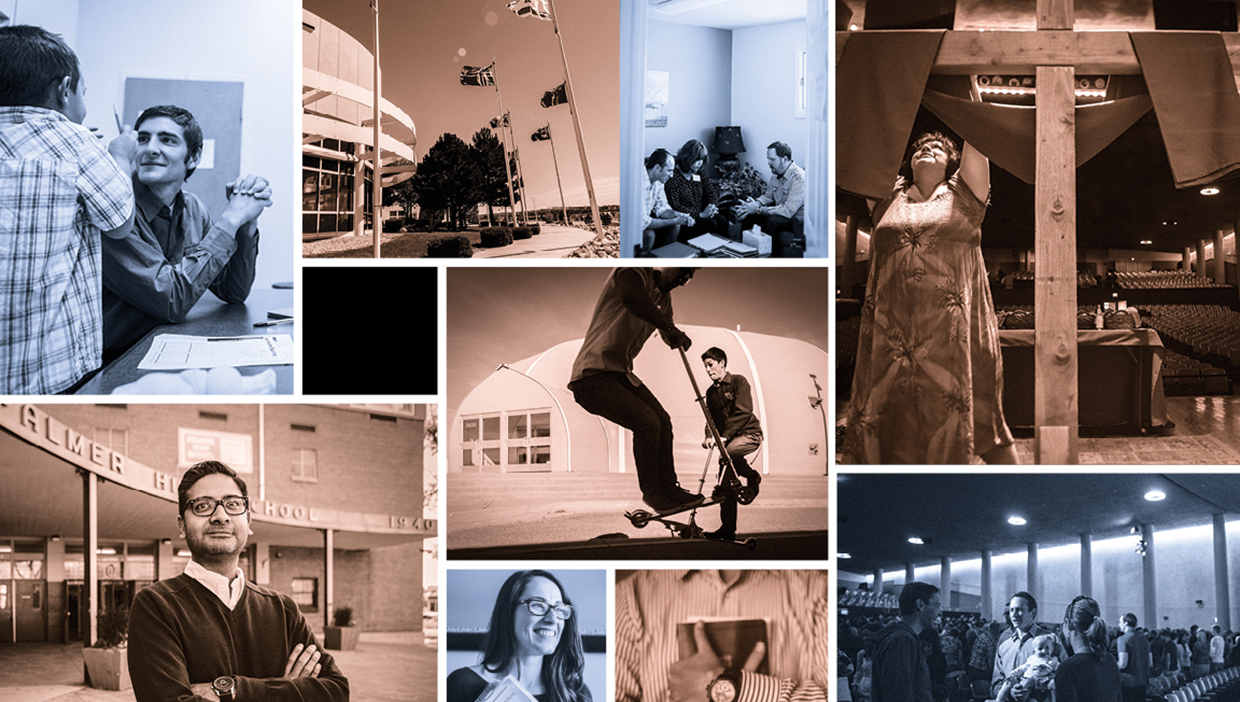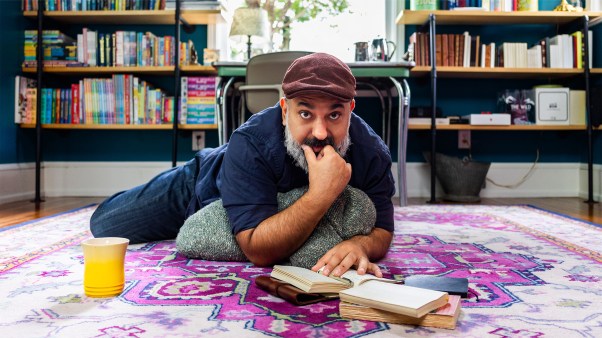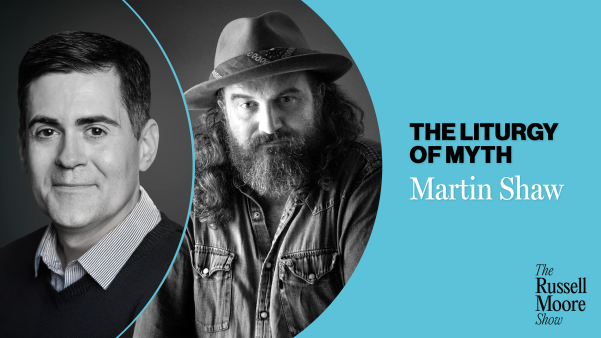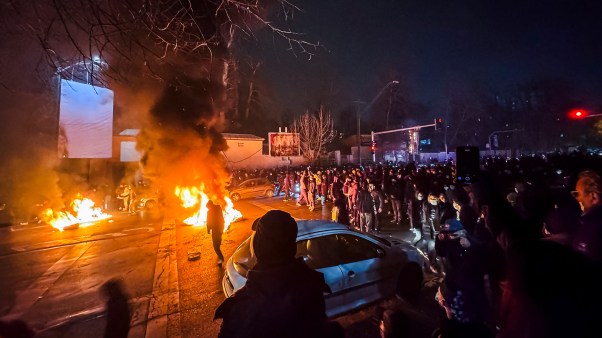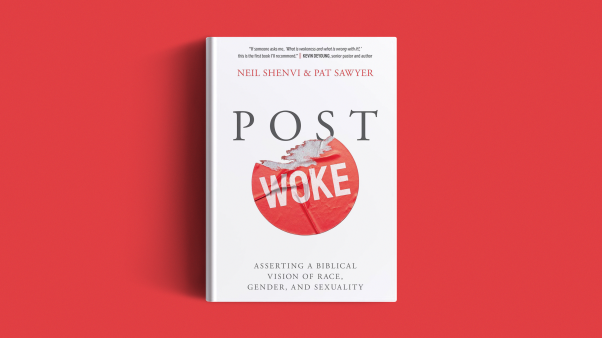The fog from the smoke machine is especially thick this Easter morning in Colorado Springs. Green lasers dance across the stage and over the thousands gathered, making no discernible pattern as they slice into the fog. The service this morning is at a fever pitch. A sprawling praise band populates the stage: guitarists and singers, a cellist, a horn section, a dj and turntable, percussionists of various sorts, a keyboardist, a pianist, and a full choir. It's a lot of sound, a lot of light—a lot of a lot.
A lot is the way Easter is announced at New Life Church. You take your standard megachurch service, and you turn it up all the way.
The year is 2006, and New Life has never basked in a brighter spotlight. Ted Haggard, who founded the nondenominational church in his basement in 1984, has been president of the National Association of Evangelicals (NAE) for two years, and he's leveraged the position into a formidable platform. Hardly a Sunday goes by without media—tv and newspaper reporters, documentary filmmakers—roaming the building, or without Haggard delivering a tale of expanding influence. He recounts a conversation with a heady politician, or an interview with a cable news talking head, that lets him redefine the evangelical stance-qua-Haggard on whatever issues are making headlines that week: abortion (con), the environment (pro), immigration (pro), same-sex marriage (con), the war efforts in Afghanistan (pro), and Iraq (super-pro).
Those far outside New Life have taken notice. A year earlier in Harper's, journalist Jeff Sharlet christened it the "nation's most powerful megachurch," observing that "no pastor in America holds more sway over the political direction of evangelicalism than does Pastor Ted." The report revealed that the "most powerful megachurch" label was not just a warning to Harper's readers; it reflected the church's own wishful thinking, too. "There was a significant influence exerted on the [2004 reelection of Bush] by Colorado Springs," Haggard told Sharlet.
This Easter Sunday is as much about celebrating that power as about celebrating God's resurrection power. Easter has arrived without spiritual preparation—no Lent, no Palm Sunday, no Holy Week (though a Passion play has packed the house for two consecutive weekends). But preparation of another kind has been under way. The church's new auditorium, with a stage set in the round and 8,000 seats, is equipped with insane lighting and sound capabilities, all on display this morning. Christ will be preached this morning—and here he is preached as the head of Christendom, leading the charge for Christians to take over the world. He is risen, and we are on the rise.
Until, suddenly, we were not.
From Christ to Christendom—that seemed to be the trajectory at New Life. By the end, we were writing policy position statements, sound-bite op-eds, and a dieting book.
Over the first weekend of November 2006, New Life's meteoric rise came to a crashing halt. Haggard resigned from his church and the NAE in the wake of accusations of drug use and a sexual relationship with a man in Denver.
New Life was left with $26 million in debt, dwindling resources, and uncertainty at every turn. More accusers came forward. In the coming months, reports of Haggard's recovery and restoration popped up, usually putting both church and former pastor in a bad light. Soon, another senior pastor was hired—Brady Boyd of Gateway Church in Dallas, who brought with him changes driven by the watchword stability.
Then, another tragedy, this one more searing: On a Sunday morning 100 days into Boyd's tenure, a gunman opened fire in the New Life parking lot, killing two teenage girls before being shot by a volunteer security guard and taking his own life.
After the two tragedies, church numbers declined almost by half—down to 8,000 members or fewer, from a reported peak of 14,000—with a corresponding decline in income. Staff faced multiple layoffs. Longtime pastors and leaders moved on. In time, the spotlight faded. And the remaining staff and members were left to recover, to remember, to rediscover what it means to be a local church.
Christendom Crumbles
I was not around New Life for much of that rediscovery. But I've been privy to some of the conversations that fueled it. From August 1998 until about four months before Haggard's scandal, I was his writer and editor. And my New Life history goes back even further: I came to Christ there in 1993 after my senior year of high school, and it's tempting to paint that era as Edenic. Volleyball and boom-boxed Nirvana on a Sunday afternoon, praise and worship in the evening, all with my new Christian friends.
I was there because Haggard and his church expressed a generous, active faith—one that helped me make sense of the world and gave me clear priorities that boiled down to, Be a blessing to the world around you. There were perhaps questionable teachings and practices in the water back then—visions, prophecies, and prayer languages that could be bewildering at times—but as far as I knew, Haggard issued a straightforward gospel, one calling Christians to give their lives to steady prayer and acts of love. That message inspired an 18-year-old boy to make some key decisions that altered his life course. I was saved at New Life, well and true.
When I began working for him, Haggard was something of a saint and a father figure. But the job was always vexed; rather, I was always vexed within it. I had changed since coming to faith—I had in fact lost faith and was trying to find it again—and the church was changing too. Haggard became famous within charismatic and evangelical circles during the 1990s, then achieved fame more widely in the early 2000s. As his profile rose, the church shifted its focus. From Christ to Christendom—that seemed to be the trajectory. By the end, we were writing policy position statements, sound-bite op-eds, and a dieting book.
As news of the scandal broke, one of my closest friends at New Life, Rob Stennett, was 90 percent through drafting a novel with the working title The Impastor (later published by Zondervan as The Almost True Story of Ryan Fisher). The novel is about a non-Christian man who attends a megachurch to drum up business, then discovers that church itself can be good business. So he starts one that becomes wildly successful—until a scandal topples it over.
Stennett was writing his way through the questions we were facing during New Life's heyday well before we knew anything about our pastor's personal problems. For many of us, Haggard's sex-and-drugs scandal was forgiven and forgotten most easily. Harder to forgive and forget was what the church had become.
I resigned a few weeks after that 2006 Easter service. I would remain close to friends and fellow staff members, but I never wanted to darken the doors of a New Life service again.
And that brings us to today.
New, Yet Quite Old
This past Easter Sunday, my family and I attended New Life Downtown. Meeting in a high school near Colorado Springs' urban core, the fledgling church branch had been looking toward Easter for months, specifically since the beginning of Advent. Pastor Glenn Packiam, 35, teaches the congregation to follow the liturgical calendar, used for centuries by major Christian traditions. During Lent, we had been anticipating the Resurrection through fasting, repentance, and sacrificial giving. Easter was preceded by a Good Friday service at the main campus. There, Packiam and associate pastor Daniel Grothe led a service of mournful prayer before dismissing us in hushed darkness.
This is part of the new language of New Life Church. Packiam is a key instigator of this new (yet quite old) way of speaking and thinking and worshiping. He's a fledgling devotee of the Anglican communion, which has attracted evangelicals seeking a historically rooted faith over the past half-century. Packiam is exploring Anglican ordination, after which he would be "sent" to New Life, a priest among evangelicals.
New Life Downtown's service remains couched in familiar evangelical expressions—there's a set of praise and worship songs, a half-hour sermon, and an overall tone of de rigueur Colorado casual. But it draws on aspects of traditional liturgy, straining to do so in a way that's both serious and inviting. Many Sundays, we recite the Nicene Creed and say the prayers of the people. Every Sunday we hear Scripture read (Old Testament, Epistle, and Gospel) and do corporate confession. We share the Eucharist, receive a blessing, and sing the doxology.
The main campus is adopting some of these practices as well. For the first time in its three-decade history, it offers Communion every Sunday. Boyd says embracing Christianity's past is key to New Life's future.
"I'm slowly turning the ship toward a more contemplative, thoughtful time," says Boyd. "I inherited a big ol' building with gigantic lights and screens. I've got all the cool stuff. But that's not what we're about."
New Life's convictions have also been examined anew. Its elders recently voted to adopt the Nicene Creed as the church's statement of faith. Meanwhile, they are tackling the legacy debt—down to $19 million as of this writing—while reaffirming a commitment to the poor in Colorado Springs. Intercessory prayer and purposeful ecumenism are also being renewed.
A number of pastoral resources have helped slowly reorient New Life. So has listening to people whose faith was jeopardized around the time of the scandal.
Gary, a New Life member, is one such person. He is a former fundamentalist who started reading broadly after Haggard resigned. A business traveler whose faith foundered amid the scandal, Gary used long commutes to study Christian history, wondering why the faith at New Life bore little resemblance to the faith he was reading about. As he studied, he brain-dumped and peppered with questions any New Life staff member who would listen: "How does the way we worship determine the way we believe?" "Why don't our songs mention Father, Son, Holy Spirit?" "Would Paul assent to our statement of faith?" Gary pointed pastors to more traditional ways of thinking, praying, reading the Scriptures, and caring for strangers, and asked: "Why do we do it our way instead of this way?"
"Gary was a representative voice," says Packiam. "There's something about listening to someone who has de-converted as a result of the faith that we had embodied. What is the church if we're not responsible for the faith that we embody and also engender in others?"
The Peterson Plan
Like several New Life pastors, Packiam had never attended seminary or received much theological instruction beyond undergrad classes at Christian schools (Oral Roberts University, for example, was a longtime feeder school for New Life). As the dust settled after Haggard's resignation and the shooting, some of the pastors enrolled in graduate programs, chiefly the Colorado Springs extension of Fuller Seminary. There, many pastors learned for the first time about hermeneutics, biblical history, and social theory. New Life ideology, long determined by the freewheeling personality and politics of a senior pastor, is now centered on insights and objections drawn from a host of teachers and scholars beyond its walls: Karl Barth, Dietrich Bonhoeffer, John Stott, Stanley Hauerwas, N. T. Wright, and—perhaps most important for pastoral practices—Eugene Peterson, author of The Message.
'I inherited a big ol' building with gigantic lights and screens. I've got all the cool stuff. But that's not what we're about.' ~ Brady Boyd
On a Monday morning about a year after the scandal, Grothe—then a fresh-faced assistant pastor—stepped into Goodwill as he did every week on his day off. Scanning the bookshelves, Grothe discovered a 99-cent copy of Peterson's The Contemplative Pastor, which presents the pastoral life as intensely local, quiet, and ordinary, a life of house and hospital visits. Reading the book shook up Grothe. This was a pastor uninterested in production—both rapid accomplishment and staged events. Peterson seemed to be hosting a completely different conversation about what it means to follow Jesus and help others do the same in the local church.
Grothe got his hands on everything Peterson had written. Then he mustered the audacity to ask Peterson for help. "I felt like I had found a pastor who lived within a congregation faithfully," he says. "I wondered, Could this be done in my context?" Could a slow, reflective, personal approach to pastoring translate at a megachurch?
Grothe had already seen hints of the model. Both his parents had served at Victory Christian Center, a large church in Tulsa. As the church grew to 10,000, the Grothes did their best to treat it like a church of 200—lots of weddings, funerals, and weekly nursing-home drop-ins on the way home from church. Grothe wondered if New Life staff could adopt his parents' model and become more invested in a ministry of presence.
In the months after the shooting, Grothe wrote the most important letter of his young life. He explained his situation to Peterson and asked if he could receive in-person pastoral counsel. To Grothe's delight, Peterson wrote back. But the reply read, essentially: Not so fast.
"He told me that churches like New Life make pastoral ministry virtually impossible. It's not about making pronouncements. It's all about knowing people, and you can't possibly know 10,000 people." Peterson asked Grothe to write a series of essays—What is a pastor? What is the church?—and then, if the essays passed muster, they could talk about meeting.
Grothe first visited Peterson in spring 2009. Slowly, a few other pastors followed, each enjoying a couple days of asking questions, discussing books (of the Bible and others), and generally having their idea of pastor shattered and reconfigured.
"Peterson has accidentally become one of the chief rabbis around here," says Grothe, now 30 and head of New Life's college ministry. "Telling it slant, gently subverting evangelical cultural norms, dropping parables that have seeped into our imagination and exploded like the truth-bomb a parable was meant to be. The work he's done has been from a distance, but he can't be gotten rid of."
No More Bottle Rockets
This is no bromide: Today New Life aims to be a church that thinks more highly of others than of itself. Staff has developed new ways of sending pastors to new ministries. In years past, it was tough to leave New Life. Leaving carried a sense of betraying the New Life way, because the New Life way was the way. But in the past few years, Boyd has helped pastors plant new churches—in Austin, Texas, Denver, and Fort Collins, Colorado. All have thriving congregations led by former members of New Life's pastoral team, and Boyd plans to send more pastors to form new congregations near and far.
'Eugene Peterson told me that churches like New Life make pastoral ministry virtually impossible. It's all about knowing people, and you can't possibly know 10,000 people.' ~ Daniel Grothe
One former member, Ross Parsley, had long been Haggard's right-hand man and was interim pastor before Boyd. While in the teeth of scandal, Parsley helped turn New Life outward, launching a "Summer of Serving" that involved members in volunteer projects, from city parks to clothing drives to helping the elderly. Later, under Boyd, New Life audited its missions spending and discovered a scattershot approach: Globally, a high volume of missionaries were receiving support, but with little direction and no way to measure impact. Locally, the church was mostly invested in what Boyd calls "bottle rockets"—one-off events that produced a lot of light and noise, but few long-term results.
"There's been a massive shift in the way we attend to our city's most vulnerable," says Matthew Ayers, a 37-year-old former Air Force officer and New Life pastor. Since 2011, Ayers has run Dream Centers of Colorado Springs (DCCS). The church established the nonprofit because, says Ayers, churches "need to create or partner with task-oriented organizations that can focus on urgent and ongoing needs."
DCCS's first order of business was to open a health clinic for uninsured and underinsured women. Besides a director and two part-time staff, the workers—a dentist, receptionists, social workers, medical assistants, nurses, nutritionists, counselors, a massage therapist—are all volunteers, meeting with 15 to 30 women each day. They have gained a solid reputation—Planned Parenthood of Colorado Springs has referred women to the clearly Christian clinic. That bodes well for DCCS's two new projects: Joel's Home, a safe place for young men leaving foster care, and Mary's Home, an apartment complex for homeless single moms and their kids.
New Life's Local Ministries is led by Bobby Mikulas, a 24-year-old with a degree in philosophy. A few years ago, Mikulas was walking and praying in Knob Hill, one of the most troubled, blighted neighborhoods in Colorado Springs. New Life had hosted a block party there in the year after the scandal, complete with free food and shoe giveaways and events for kids. It was successful, but it was also a bottle rocket.
As Mikulas walked with some Knob Hill residents, one of them called him on it: "Look, if you're going to get involved down here, stay consistent with us. You can't drop in, give shoes away, and not come back. We'd rather you not come at all."
That feedback now drives most every Local Ministries project, such as a summer camp for abused and neglected kids in foster care, a program for gathering and redistributing used goods, and a hosting program for homeless families. In all cases, New Life is not pioneering anything. Instead, they're working with local agencies—an array of churches, state-run organizations, and interfaith nonprofits who already have expertise. Little of this is announced, much less ballyhooed.
"It's humble work for anyone who volunteers," says Mikulas. "We have a kids' mentoring program in Knob Hill. It's only 20 people. But it's every week. It's consistent. You show up every time. That reflects the character of God."
None of the programs are unique among local churches—nor are they out of character with New Life's long (for this Western town) history. But it's a crucial course correction.
"There were already people from the church hanging around the city and handing out clothes, buying meals for the homeless. But we're applying thoughtfulness and care," says Ayers, noting the church's new willingness to link up with expert organizations.
Big-Tent Megachurch
When I embraced faith at New Life, I started to do what Christians around me were doing: dancing in the aisles, speaking in tongues, pacing back and forth in prayer. New Life doesn't foreground these distinctives as much as it used to, but they're still present. There's a long prayer service every Sunday night and an intense noon prayer session each weekday. Both events are overseen by David Perkins, who also leads the church's youth program, Desperation Student Ministries, as well as a biannual youth conference that hosts 7,500 to 10,000 teenagers. Then there's the Youth Leader Prayer Summit, which draws 200 youth ministers to pray and talk, and the Desperation Leadership Academy, an internship program where college-age students spend at least 16 hours per week plus daily devotional time praying.
Perkins's approach is distinct from that of the other pastors I've mentioned. (His roots are the renewal prayer movement, expressed in places like the International House of Prayer in Kansas City, Missouri.) But it's not out of step with New Life's legacy—or future.
"I wanted to come here because New Life was known as the praying church," says Perkins, 36, who arrived in 2000. Under Haggard, Perkins built ministries that focus on prayer—teaching it, encouraging it, and doing lots of it. His work, more than that of any others I've spoken of, continues unabated on both sides of the twin tragedies.
Perkins wants to maintain New Life's prayerful past, including its association with charismatic and Pentecostal prayer movements. Desperation Leadership Academy is housed within the World Prayer Center (WPC), a 50,000-square-foot complex built in 1998 on New Life's campus for the sole purpose of prayer, especially intercessory prayer. The WPC took some strange and excessive turns over the years—politicizing spiritual warfare, for example, and encouraging intercessors to see God's hand in America's geopolitical efforts—but Perkins is determined to see it remain a house of prayer, "and not just become another conference center."
The various expressions of Christian discipleship at New Life—liturgy, reexamining theological commitments, refining and humbling the pastoral office, attending to the needs of Colorado Springs's most vulnerable, and charismatic prayer and worship—are possible in some ways only because New Life remains a megachurch. It remains a big tent, but now it's one without a unified brand or personality. Under the tent is room for multiple expressions of obedience to Christ in the 21st century.
These approaches aren't just different flavors of the faith. Each has its own internal makeup and core commitments, and sometimes one pastor's commitments are at odds with another pastor's. To be sure, tensions arise between the New Life leaders who have discovered liturgy and academic theology, and those who hew closer to the church's charismatic heritage. It is tricky to appropriate ancient Christian worship practices when those practices implicitly critique the popular, high-decibel approach of megachurch services. But the pastors talk it through—in staff meetings, over meals, even on Twitter for all to see.
Boyd wants these distinctives to flourish alongside one another. He tells me about a recent Sunday night prayer service where one of Perkins's musicians created a song on the spot and led the congregation in belting it out. "On Sunday nights, some of the things we do are two seconds old," says Boyd. "Downtown and elsewhere, some of the things we do are nearly 2,000 years old."
At worship one Sunday this summer, Communion stations were set up along the back of the New Life auditorium, waiting with their wafers and cups of purple. The band prepared their instruments, then the keyboardist offered a bed of music, a signal that it was time to begin. Worship leader Jon Egan stepped to the microphone, encouraging people to sing along, focus, and involve themselves in the service: "We're not here to be entertained by any man."
Patton Dodd is the editor in chief of On Faith and author most recently of The Tebow Mystique (Patheos Press).

